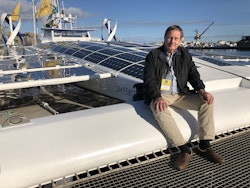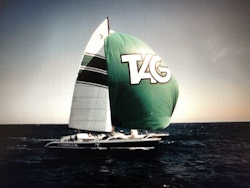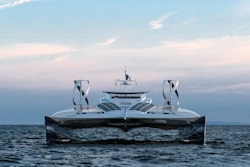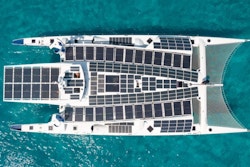Nigel Irens: It's a pleasure to see the new life of the boat
Francis Joyon, Ellen MacArthur and before them, Mike Birch, winner of the first Route du Rhum and Sir Peter Black, Enza, have put their trust in Nigel Irens to design their record-chasing engines. Energy Observer came off the naval architect’s drawing board in 1983 under the name of Formule TAG. Lengthened and transformed into an experimental vessel, the 30-meter catamaran today explores the planet. Meeting with its architect.

On the pontoons of the Route du Rhum, a spry person in his sixties is casting his astute eye over the vessels moored in Vauban Marina. The British naval architect Nigel Irens is the father of quite a few of them. But it’s certainly Energy Observer which has held his attention the most. In 1983, Formule TAG was the world’s biggest record-chaser.

Formula TAG
Lengthened and modified, Energy Observer now explores the planet with Victorien Erussard at the helm. The opportunity for a passionate discussion in the cockpit, version V2, of a vessel which only continues to increase the experience.
In 1982, when Mike Birch contacted you to design his new vessel, what were his specifications?
It was a time when catamarans dominated, with Loïc Caradec’s Royale II, Marc Pajot’s Elf Aquitaine or Charente Maritime skippered by a group of friends led by Jean-François Fountaine. Formule TAG (editor’s note: the original name of Energy Observer) had to be, with its 80 feet (24.37 meters), the largest catamaran of its time.
What was the vessel’s program?
Mainly crewed races but also record attempts.
You designed it, the work was coordinated with the architectural firm Huot and Dupuis, but where was it built?
It was built in Montreal (Canada) by the aviation company Canadair, the property of TAG the sponsor. The most notable change was the size. Nobody had ever made such a big vessel.
Has the catamaran therefore benefited from the technology of the aviation industry?
This was a real opportunity. It’s the first racing vessel to have benefited from aviation standards with Kevlar material (pre-preg of resin (prepeg). At the time, it was the world’s second largest composite object… just after the doors of the space shuttle!
Why choose Kevlar?
Kevlar was available in larger quantities than carbon in the 1980s. It then became outdated because it had very good mechanical qualities in traction but a lot less in compression since its adhesion between resin and fibers is not very good. All the planks were made of Kevlar. Carbon was used for the deck edge (editor’s note: deck and hull junction line). The same for the arm parts where there was a lot of compression. The challenge was to adapt this standard aerospace technology, which used autoclaves, to our requirements where we were unable to use autoclaves due to the size of our parts. We did a lot of testing with the help of Canadair personnel.
Were there any anecdotes during construction?
Assembling was done in a shed in Quebec in a public area that was open to the public, as part of the 400th anniversary celebrations of Malouin Jacques Cartier’s discovery of Canada. It was sometimes a bit surreal when we were working at night to the sound of an orchestra. We also learned six weeks before its inauguration that the vessel was going to sail on the day of its launch with Pierre Elliot Trudeau, Canadian Prime Minister, on board. It was tight in terms of organization. We strengthened the teams and worked day and night. On launch day, a turnbuckle (editor’s note: a device which holds the cables) was defective. We have anyhow sailed under reduced sails with “do-it-yourself” workmanship!
The fact that the vessel is today a new life, is this important for you?
It’s very important! After 35 years and the different lives that this vessel has had, it’s great to see it continuing. Especially in this context of choosing to recycle a vessel rather than building a new one is a good example.
What are your thoughts on the vessel’s transformation and changes?
The load on the structure in this new configuration (editor’s note: the pod in which the crew lives) doesn’t pose any structural problem to the hulls. It doesn’t risk anything compared to what happens to a vessel whose hulls are loaded by sail plan efforts. The loads are minimal compared to what it has endured during its different world tours. The vessel is in refuge! A great refuge for a great project. I’m very impressed with the quality of the transformation.

